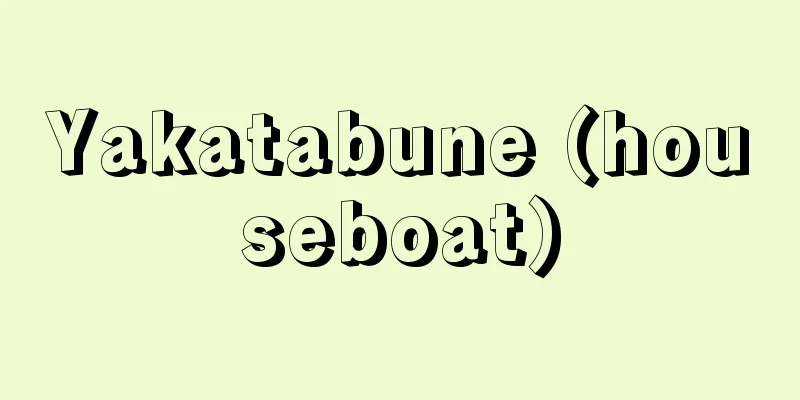Yakatabune (houseboat)

|
A boat with a yakata (a house-shaped cover) attached to it, used for river sports, etc. Also called a rousen (ro-sen). Dating back to the Heian period, yakata were often attached to boats used by aristocrats for leisure, ships transporting tax, and merchant ships. Among them were simple yakata called kakisue yakatabune, which continued to be used after the Heian period depending on their purpose. However, yakatabune generally refers to the luxurious pleasure boats that feudal lords and wealthy merchants floated on the river during cherry blossom viewing, summer cool-down, fireworks, and moon viewing in the Edo period. In Edo, the area around Ryogoku Bridge on the Sumida River was famous, and they became large ships during the Joo and Manji years (1652-61). The Kumaichimaru (Kumaichimaru) had nine rooms and one kitchen, while the Yamaichimaru (Yamaichimaru) had eight rooms and one kitchen. "The yakatabune looks like a mountain crawling out of a room," says one senryu poem, and the hulls of the boats were decorated with metal fittings and lacquer, and the sliding doors of the cabins were painted with the utmost luxury. Geisha were brought on board to hold drinking parties, and sometimes two yakatabunes were tied together to make one into a dancing boat. Samurai would prop up spears on the yakata to show their strength, and there were large two-story yakata in Osaka. The heyday of yakatabunes was during the Kanbun and Enpo eras (1661-1681). In 1682 (Tenwa 2), the shogunate stipulated the dimensions of ships and banned large ships. The use of yakatabune (roofed boats) declined due to successive frugality edicts thereafter and the construction of simpler roofed boats. [Fumio Inagaki] Source: Shogakukan Encyclopedia Nipponica About Encyclopedia Nipponica Information | Legend |
|
川遊びなどに用いられた屋形(家の形をした覆い)を据え付けた船。楼船(ろうせん)ともいう。古くは平安時代にさかのぼり、貴族の遊山(ゆさん)用の船、年貢輸送船、商船などに屋形をつけることが多かった。そのなかには舁据(かきすえ)屋形船とよばれる簡易な屋形もあり、平安以後も用途により絶えることなく続いた。しかし一般に屋形船といえば、江戸時代、花見、納涼、花火、月見の際に大名、豪商などが川面(かわも)に浮かべた豪華な遊覧船をさす。江戸では隅田川の両国橋付近が有名で、承応(じょうおう)・万治(まんじ)年間(1652~61)には大型船になった。九間一(くまいち)丸(熊市丸)は座敷九間(ま)に台所一間(ま)で、八間一(やまいち)丸(山市丸)は座敷八間に台所一間あった。「屋形船、山の這(は)い出る如(ごと)くなり」と川柳にもあり、船体は金具や漆で飾り、船室の襖絵(ふすまえ)に贅(ぜい)を尽くした。芸妓(げいぎ)を乗船させて酒宴を開き、ときには屋形船を二艘(そう)つないで、一艘を踊り船とした。武士は屋形に槍(やり)を立てかけて威勢を示し、大坂には二階造りの大屋形もあった。寛文(かんぶん)・延宝(えんぽう)年間(1661~81)が屋形船の全盛期であった。幕府は1682年(天和2)に船の寸法を定め大船を禁止し、その後も相次ぐ倹約令により、また簡易な屋根船(やねぶね)の新造によって屋形船の使用は減少した。 [稲垣史生] 出典 小学館 日本大百科全書(ニッポニカ)日本大百科全書(ニッポニカ)について 情報 | 凡例 |
Recommend
Clouds and Shadows
〘Noun〙 ("kage" means cloudy) The sky is ...
Zeno (of Cyprus) (English spelling)
335 - 263 Greek philosopher from Kition, Cyprus. F...
Prime number - sosuu (English spelling) prime number
A natural number other than 1 that has no divisor...
Aelia Galla Placidia
Around 388 or 390-450 A Roman princess. Born to Th...
Hemigraphis reptans (Forst.) T.And.ex Hemsl.
A small perennial plant of the Acanthaceae family....
Kantetsu (liver fluke) - Kantetsu
A large leaf-shaped worm that can grow up to 3cm i...
Quneitra (English spelling)
A city in southwestern Syria. Located in a valley ...
oratores
…These three estates were thought to be united in...
SNAM
…Like IRI (Industrial Reconstruction Corporation)...
Orbital Eye - Kagan
…When the epidermis where the photoreceptor cells...
Acker
American playwright, novelist, and poet. Her works...
《Ki-soku Taigi》
…He passed the imperial examination in 1825, but ...
Isis - Isis (English spelling)
A goddess worshipped in ancient Egypt, Greece, an...
Széchenyi István
Born: September 21, 1791 in Vienna [Died] April 8,...
Kakekotoba - Hanging Words
A rhetorical device in waka poetry. It is also wr...
![Noshiro [city] - Noshiro](/upload/images/67cc7add34b98.webp)








